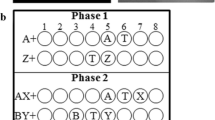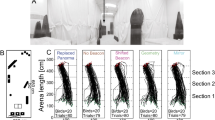Summary
-
1.
Three pigeons (Columba livid) were trained to find hidden food in a sunken well (3.3 cm in diameter) at a constant place within an (160 cm×160 cm) experimental box (Fig. 1). After learning the location, the animals were tested occasionally with the well and food absent. Landmarks in the experimental box might be transformed on such tests.
-
2.
Changing the height or width of a nearby landmark had no systematic influence on the position of peak search. Translating a nearby landmark, however, led to a shift in peak search position. All three birds then searched most somewhere between the original goal location, as defined by the unmoved landmarks, and the goal location as defined by the shifted landmark. Within a limited range of landmark shift, the peak shift as a function of landmark shift is linear (Fig. 3).
-
3.
To explain the data (Fig. 7), the pigeon records at the location of the goal the algebraic vectors from a number of landmarks to the goal. These vectors have both a direction and a distance component. When searching for the goal again in the experimental box, it computes independently for each landmark a navigation vector. This is arrived at by vector-adding the algebraic vector from the bird's current position to the landmark in question, supplied by perception, to the corresponding landmark-goal vector in its record. The pigeon moves in the direction and distance specified by a weighted average of the independently calculated navigation vectors. For positive vector weights, vector geometry guarantees that the bird would search somewhere between the original goal and the goal according to the shifted landmark. The extent to which it shifts toward the shifted goal reflects the vector weight given to the shifted landmark.
Similar content being viewed by others
References
Cartwright BA, Collett TS (1983) Landmark learning in bees. J Comp Physiol 151:521–543
Cheng K (1986) A purely geometric module in the rat's spatial representation. Cognition 23:149–178
Cheng K, Collett TS, Pickhard A, Wehner R (1987) The use of visual landmarks by honeybees: bees weight landmarks according to their distance from the goal. J Comp Physiol A 161:469–475
Collett TS, Cartwright BA, Smith BA (1986) Landmark learning and visuo-spatial memories in gerbils. J Comp Physiol A 158:835–851
Gallistel CR (1980) The organization of action. Erlbaum, Hillsdale
Goodale MA (1983) Visuomotor organization of pecking in the pigeon. In: Ewert J-P, Capranica RR, Ingle DJ (eds) Advances in vertebrate neuroethology. Plenum, New York, pp 349–357
Kamil AC, Balda RP (1985) Cache recovery and spatial memory in Clark's nutcrackers (Nucifraga columbiana). J Exp Psychol Animal Beh Proc 11:95–111
Olton DS (1978) Characteristics of spatial memory. In: Hulse SH, Fowler H, Honig WK (eds) Cognitive processes in animal behavior. Erlbaum, Hillsdale, pp 341–373
Roberts S (1981) Isolation of an internal clock. J Exp Psychol Animal Beh Proc 7:242–268
Roberts WA, Van Veldhuizen N (1985) Spatial memory in pigeons on the radial maze. J Exp Psychol Animal Beh Proc 11:241–260
Sherry DF (1984) Food storage by black-capped chickadees: memory for the location and contents of caches. Animal Beh 32:451–464
Shettleworth SJ, Krebs JR (1982) How marsh tits find their hoards: the roles of site preference and spatial memory. J Exp Psychol Animal Beh Proc 8:354–375
Spetch ML, Edwards CA (1986) Spatial memory in pigeons (Columba livia) in an open-field feeding environment. J Comp Psychol 100:266–278
Suzuki S, Augerinos G, Black AH (1980) Stimulus control of spatial behavior on the eight-arm maze in rats. Learn Motiv 11:1–18
Vander Wall SB (1982) An experimental analysis of cache recovery in Clark's nutcracker. Animal Beh 30:84–94
Wehner R, Raeber F (1979) Visual spatial memories in desert ants,Cataglyphis bicolor (Hymenoptera: Formicidae). Experientia 35:1569–1571
Author information
Authors and Affiliations
Rights and permissions
About this article
Cite this article
Cheng, K. Some psychophysics of the pigeon's use of landmarks. J. Comp. Physiol. 162, 815–826 (1988). https://doi.org/10.1007/BF00610970
Accepted:
Issue Date:
DOI: https://doi.org/10.1007/BF00610970




